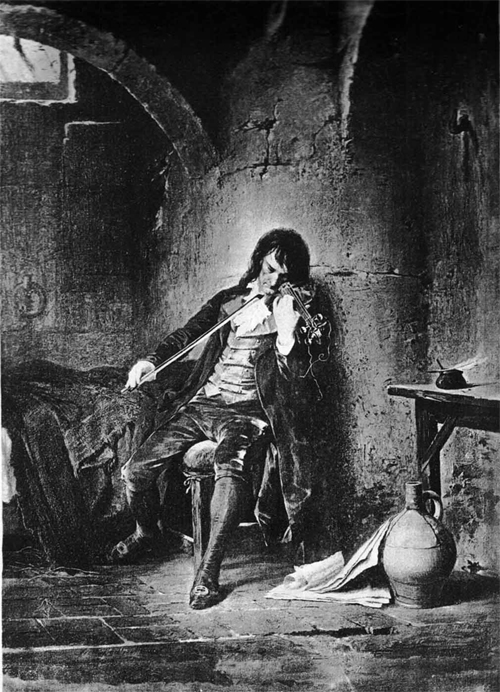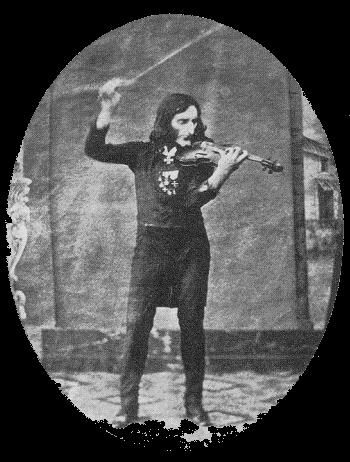Paganini in Prison by Ferdinand BarthPleasures of Music
Free Paganini!
‘Thus, my dear sir, does the reputation of an artist become the plaything of idle talk’
When Nicolo Paganini, one of the most celebrated violin virtuosi of his time, whose reputation as a musician was rivaled only by his reputation for womanizing and gambling, arrived in Paris in February 1831--his first visit--he found lithographs on display depicting him variously as a convict in chains, as a murderer caught in the act, and other discreditable guises. He addressed his defense to the musicologist and critic who was also his friend, F.-J. Fétis (1784-1871).
To F.-J. Fétis, editor of the Revue Musicale
Paris (1831)Sir:
The French public has shown me such kindness and has been so generous with its applause that I am forced to believe in the renown which, it is said, preceded me in your city. I am also led to hope that my concerns have not fallen too far below their reputation. But had I any doubts about my notoriety, it would be dispelled by the zeal which I see your artists have used in portraying me and placarding with my name the walls of your capital. Unfortunately, they have not stopped at mere portraits, for walking one day on the Boulevard de Italiens, I saw in an engraver’s window a lithograph purporting to depict “Paganini in Prison.”Well, said I to myself, here are honest folk using for their profit a certain slander which has dogged me for fifteen years. While I gazed and laughed at the travesty which the artist had tricked out with full details drawn from his imagination, I noticed that a large circle of passers-by had collected around me and, while audibly comparing my features with those of the youth in the picture, were remarking how much I had changed since my prison term.
I then saw that the affair was being taken seriously by those you call, I believe, “rubbernecks,” and I inferred that the forgery was indeed a good business venture. It occurred to me that since everyone must live, I might as well furnish a few more anecdotes to the portraitists who are good enough to use me in this fashion, and so enlarge their repertory. It is to this end, sir, that I beg you to publish that present letter in your Revue Musicale.
Yehudi Menuhin, with Adolph Bailer at the piano, performs Paganini’s ‘Moto Perpetuo’ (1947)The gentlemen in question have depicted me in prison, but they do not know how I came there; as to which they know exactly as much as I, or as those who first circulated the tale. There are several versions, which could supply as many different subjects for art. It has been said, for example, that having surprised my rival with my mistress, I courageously slew him from behind, at the moment when he was least capable of self-defense. Others have maintained that my jealous fury wreaked itself on my mistress alone, but there is no agreement about the mode of my dispatching her. Some say a dagger, others affirm that I chose to enjoy her sufferings by administering poison. Each has followed his free fancy, and I would extend the same liberty to the lithographers.
At any rate, this is what befell me at Padua about fifteen years ago: I had given a concert there with considerable success. The next day I was seated at the table d’hôte among sixty others--no one had noticed my entrance--when someone expressed his enthusiasm about the effect I had produced on the audience the day before. His neighbor seconded this praise, adding that “there was nothing surprising in Paganini’s virtuosity. It is the result of his being eight years in prison with only his violin to mitigate his solitary confinement. He was convicted for the cowardly murder of one of my friends, who happened to be his rival in love.”
Jascha Heifetz, Paganini Caprice No. 24Everyone was indignant, as you may imagine, at the baseness of the crime. Whereupon I spoke up and, addressing myself to the person who was so familiar with my history, begged him to tell me in what place and year this adventure had occurred. Everyone’s eye turned to me in astonishment at discovering the chief actor of the tragedy. The narrator was much put out. It was no longer his friend who had perished--it had merely been said--he had been told--or rather he had believed--but no doubt he had been misled--. Thus, my dear sir, does the reputation of an artist become the plaything of idle talk--the sport of people who are too lazy to imagine that a man can as readily study and practice of his own free will in his room as locked up in a cell.
In Vienna a still more ridiculous rumor arose to test the credulity of some enthusiasts. I had played there some variations entitled Le Streghe (The Witches). They had proved rather effective; so that a gentleman (who was described to me as pale, melancholy, and rapt of gaze) asserted that he found nothing amazing in my technique, for all through my playing of the variations he had distinctly seen the Devil near me, guiding my bow arm. The Devil’s striking resemblance to myself sufficiently proved my ancestry. The Devil was dressed in red, bore horns, and carried his tail between his legs. You can conceive, sir, that after so minute an identification it was impossible to doubt the report, and many persons were persuaded that they had at last found the secret of what is called my tours de force.
My peace of mind was long at the mercy of these stories. I vainly tried to show their absurdity. I pointed out that since the age of fourteen I have never ceased to play before public audiences; that for sixteen years I was orchestra conductor and music director at Lucca; that accordingly if I had spent eight years in prison for killing rival or mistress, it must have been at an earlier time and hence that I must have had this mistress and rival at the age of seven.
Itzhak Perlman, Paganini Caprices Nos. 1, 5, 24In Vienna I called on my ambassador, who testified that he had known me for nearly twenty years as a man of standing and probity, and thus did quell for a time the course of slander. But it can never be wholly stilled, and I was scarcely surprised to find it springing out again in Paris. What, sir, am I to do? I see nothing open to me but to resign myself and let malice do its worst. Perhaps, though, I should apprise you of yet another anecdote that has lent color to the libelous attacked made upon me.
This is it: a violinist named D----i, resident in Milan, became friendly with a pair of shady characters and was persuaded to join them in an attack on the curate of a neighboring village, who was reputed to keep a large sum in his house. Fortunately, one of the trio lost heart and denounced the plot to the police, who seized D---i and his accomplice just as they reached the curate’s house. They were condemned to twenty years in irons. But General Menou, after he became Governor of Milan, set the musician free after two years. Incredible as it may seem, that is the canvas for the embroidery fashioned to discredit me. A violinist whose name ends in i must be Paganini. The plot became the murder of my mistress or rival, so that none but myself could plausibly have been in prison. Still, since I was supposed to develop my new technique there, the irons had to dispensed with and my arms left free.
I repeat: since they wish it so, against all probability, I must yield. But I cling to one hope, which is that after my death Calumny will let go its prey, and that those who have so cruelly avenged themselves for the reality of my fame will leave my ashes in peace.
Yours, etc.,
Paganini
Founder/Publisher/Editor: David McGee
Contributing Editors: Billy Altman, Laura Fissinger, Christopher Hill, Derk Richardson
Logo Design: John Mendelsohn (www.johnmendelsohn.com)
Website Design: Kieran McGee (www.kieranmcgee.com)
Staff Photographers: Audrey Harrod (Louisville, KY; www.flickr.com/audreyharrod), Alicia Zappier (New York)
E-mail: thebluegrassspecial@gmail.com
Mailing Address: David McGee, 201 W. 85 St.—5B, New York, NY 10024




